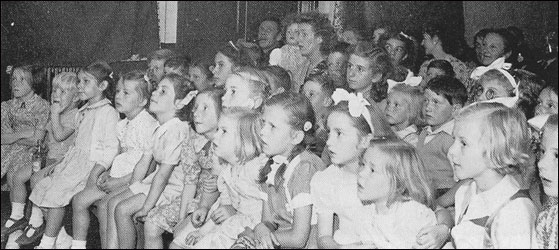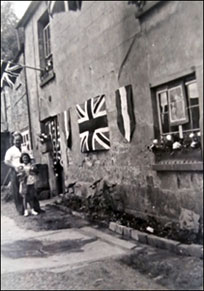|
CHILDHOOD MEMORIES
By Sue Morley (nee Tustain) and Hazel Canvin (nee Lavington)
We have been friends for seventy years and spent an idyllic childhood in Cosgrove. We were both born in 1945.
Our earliest memories are of the Victory Hall being built in July 1949. Lots of the village people gave a lot of their time to help build it – Hazel’s dad being one of them.
The hall became to hub of post war village life, taking over from the old school which was at the far end of the village. Hardly any families had television in the village at that time so the social life largely consisted of Whist, Domino and Beetle drives, with weekly “picture”. In Captain Atkinson’s speech at the grand opening of the village hall, he said, “Cosgrove will live and be merry now, in their own hall.” How true those words turned out to be.
Friday night was “Picture” night; ladies arriving with a cushion, to ease the pain of the hard chairs, and children racing for the front seat, to await the great Laurel and Hardy, and Old Mother Riley. Sue can remember running to the back to sit on her mum’s knee.

The rear of the group includes Jim Holman, Dolly Williams, Mrs Nora Horton, Vera Stewart, Susan Coles, Tony Lavington, Sylvia Wickham, Louie Gascoigne, Jessie Stewart, Sheila Brown, Rosemary Hebson. The front includes Jo Hebson, Ivor Hickford, Carol Prater, Pauline Bushell, Julie Longman, Jill Tustain, Jill Hebson, Sue Tustain and June Smith.
We were too young to go dancing, but hung around outside the hall, sometimes being allowed in until 9 pm with Sue’s dad coming to fetch her – after he had had a dance, of course, with one of the ladies, One of his favourites was Flo Castle, who could dance a very good quickstep.
We soon scuffed the new floor once Gwendaline Randall’s School of Dancing was established. I wonder how many can remember the Skating routine in the tap dancing section? We had little white skirts made from old sheets with a red and white jacket and hat. We were so proud. Gwendaline Randall also taught ballet and acrobatics. Neither of us were born ballerinas so we preferred tap dancing. Sue didn’t particularly enjoy acrobatics either, but Hazel was the whizz kid when it came to the “Chest Roll” and the “Belt”. Bridget Cummings would swing her completely round her waist holding onto Hazel’s feet, making a belt around her waist.
We had the important job of going round the village with the weekly raffle for the Whist Drive, with Olive Johnson in charge of the money and prizes. We called at lots of houses, and many of the older residents would ask us in for a chat.
By the time of the Coronation in 1953 lots of parties were planned, with everybody getting a chance to see the event on somebody’s TV. We saw it on Gladys Williams’ set. In the afternoon the whole village had a tea party. Cosgrove School were at the Priory, and other groups went to Whiting’s, Hesketh’s and the village hall itself. Hazel’s old cottage in Suet Alley, as her mum called it, was awarded second prize in the best decorated house competition.

In the evening there was a huge party in the hall, with a firework display and a bonfire. The thing that many people will remember most is one really big firework going off at the beginning. What we didn’t realise was that a spark had flown from the bonfire into the box and set the whole lot off! We don’t think there were many sober adults in Cosgrove that night.
Soon after the Coronation, children at Cosgrove School went to the Scala Cinema at Stony Stratford to see the Royal event on film. We remember being mortified en route to Stony, as we travelled in Captain Atkinson’s horse box, because the older boys told us that it had been used to transport a body from the river prior to the celebrations.
The Victory Hall was also used for changing rooms for the local football team. We called them the “Lilywhites” and they played in the field at the back of the hall. They were able to use the modern facilities of showers, that were virtually unheard of at the time.
Sue’s dad, Fred Tustain, was caretaker at the hall and was kept very busy with functions going on most of the time, particularly in the winter months, as the central heating was fired by “coke”. The hall was a convenient hideout, in the showers and coke-hole, after we’d been scrumping “Aub’s Strawbs”, “goosegogs” and old Mrs Welch’s apples.
We never actually got caught red-handed, but we did get caught out in the Church. One harvest time, we arrived for the service long before the start time, so we decided to have fun with Sue pumping the organ and Hazel attempting to play it. Suddenly, we heard the door into the Chancel open. We scurried off and hid behind a sheaf of corn. We wondered why the vicar at the time said, “I don’t need to ask who it is – come out Hazel and Sue!”
Beside the Firework and Bonfire celebrations at the Coronation, there was an annual bonfire in the grounds of the village hall on Guy Fawkes night. We collected all round the village for rubbish to go on it – old tyres, newspapers and so on. Many a happy hour was spent reading old comics that we collected prior to that night. The bonfire was always huge and would last from early evening, well into the next day. During the evening the children let their fireworks off, and later, the adults would arrive, ending the evening with a singsong, linking hands around the fire. It was a nightmare for Ethel Barby, who lived in the thatched cottage near to the hall, because she was afraid one of the rockets would land in the roof.
During the early fifties most of the thatched cottages disappeared when the new council houses were built at Manor Close. The residents were given new homes with flush toilets and bathrooms, and the old houses were condemned. These made an ideal playground for us, with games like “Truth”, and “Mums and Dads”. We tried our first fags there! These cottages stood empty for a long time, eventually being bought by Billy Betts, who knocked the whole lot down. If only we knew then what we know now! Then these charming cottages would have survived.
Maybe we were two of the lucky ones, growing up in these idyllic surroundings. It certainly equipped us for life outside the village, going on to raise our own families with a true sense of value. There is still a strong tie that pulls us back time and time again, visiting the local pub, the Barley Mow, to keep in touch, the occasional service at the Church, and, of course, to tend our parents’ graves in the churchyard.
|